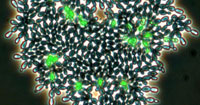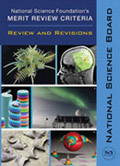Each month, the NSF Current newsletter highlights research and education efforts supported by the National Science Foundation. If you would like to automatically receive notifications by e-mail or RSS when future editions of NSF Current are available, please use the links below:
![]() Subscribe to NSF Current by e-mail |
Subscribe to NSF Current by e-mail | ![]() What is RSS? |
What is RSS? | ![]() Print this page |
Print this page | ![]() Return to NSF Current Archive
Return to NSF Current Archive

New research suggests it may be possible to use brain technology to learn to play a piano, reduce mental stress or hit a curve ball with little or no conscious effort. It's the kind of thing seen in Hollywood's "Matrix" franchise.

U.S. and Japanese researchers analyzing the levels of radioactivity discharged in the first four months after the 2011 Japan earthquake and tsunami found that the levels, while high, are not a direct threat to humans or marine life.

With the steep decline in populations of many animal species, scientists have warned that Earth is on the brink of a mass extinction like those that have occurred just five times during the past 540 million years.

Astronomers discovered the most massive black holes to date in two separate nearby galaxies. Each black hole has a mass equivalent to 10 billion suns.

Newly excavated remains in central Alaska may belong to one of the earliest inhabitants of North America and may provide rare insights into the burial practices of Ice Age people.

Highly publicized cases of online bullying, or cyberbullying, are getting attention from parents, teachers, school administrators and academic experts. But some experts ask: Is "cyberbullying" a real culprit? The answer depends on who's asked. Watch a video of psychologist Sheri Bauman on strategies to prevent cyberbullying.

More than 500 million years ago, single-celled organisms on Earth's surface began forming multi-cellular clusters that ultimately became plants and animals. But how that happened is a question that has long eluded evolutionary biologists.
NSF-supported scientists at the University of Minnesota have replicated that step in the laboratory using common Brewer's yeast, a single-celled organism. In 60 days, the yeast developed multi-cellular clusters that work together cooperatively, reproduce and adapt to their environment. In essence, they developed into precursors of the types of life that exist on Earth today. The research was supported by NSF grants 0918897 and 1051115.
Read more and view a video about the results, published January 17, 2012, by Proceedings of the National Academy of Sciences.

A National Science Board task force conducted an examination of the two merit review criteria--intellectual merit and broader impacts--that NSF uses to evaluate every proposal it receives. Several thousand individuals from stakeholder groups provided input. The report, released in January, concluded that the criteria are appropriate for evaluating proposals but recommended revising the descriptions to give the NSF community a better understanding of the criteria and how they relate to each other. In addition, the report identified three principles that apply to NSF's use of the criteria:
- All NSF projects should be of the highest quality and have the potential to advance, if not transform, the frontiers of knowledge.
- NSF projects, in the aggregate, should contribute more broadly to achieving societal goals.
- Assessment and evaluation of NSF-funded projects should be based on appropriate metrics, keeping in mind the likely correlation between the effect of broader impacts and the resources provided to implement projects.
Read more in the NSF press release.
According to Science and Engineering Indicators 2012, a biennial report on the U.S. and international science and engineering enterprises, the United States conducts more science and technology research and development (R&D) than any other nation. But the Asian region is rapidly increasing its R&D investment and overtaking the United States. In China alone, R&D growth increased a stunning 28 percent in 2008-2009, with another 20 percent increase reported for 2009-2010, propelling China past Japan and into second place behind the United States.
For more information, see the NSF press release or Chapter 4 of the report, published in January 2012 by the National Science Board.

No one is in a better position to monitor environmental conditions in remote areas of the natural world than the people living there.

Stanford University ecologist José Fragoso demonstrated the value of enlisting local, non-scientist residents in efforts to collect field data over large areas. He successfully completed a five-year study of a 48,000-square-kilometer tract in the Amazon Basin with the help of 340 villagers trained in scientific survey techniques, such as walking a transect, recording sightings of plants and animals, and marking observations on a map.
Younger villagers with formal education were often paired with older villagers, many of whom could not read, write or do arithmetic but were expert bushmen. In all, the technicians logged 48,000 sightings of 267 animal species. They also recorded more than 33,000 locations of plants on which the animals feed. The partnership allowed the researchers to gather far more data than otherwise would have been possible.
Learn more from this video and Stanford press release. Fragoso's research is supported by NSF grant 0837531.
In Eureka Park, Start-ups Get a Slice of CES (The Washington Post) The International Consumer Electronics Show isn't just for "big-wigs" like Google and Qualcomm. This year, CES featured a special area for start-ups. NSF has given grants to 28 of the exhibitors.
NBC Brings 'Science of NHL Hockey' to TVs, Classrooms (The New York Times) A series of educational segments on the "Science of NHL Hockey" made their debut during the NBC Sports Network's coverage of the All-Star festivities. In each video, an NSF-supported scientist explains a science principle.
Commentary: Science Rediscovers Entrepreneurship (CNBC) Over the last two months, the U.S. government has been running one of the most "audacious" experiments in entrepreneurship since World War II--the Innovation Corps, set up by NSF as an incubator for scientists.


How many people would have heard of fractal geometry, double helix, or solar flares if it weren't for the spectacular images? Illustrations can encourage popular interest in science and engineering and help in understanding complex research developments. NSF and the journal Science created the International Science & Engineering Visualization Challenge to celebrate and encourage the visual communication of science for educational and journalistic purposes.
Winners were announced in five categories: Photography, Illustrations, Informational Posters and Graphics, Interactive Games and Videos. The winning entries are featured in the February 3 Science and on the NSF website. For the first time in the history of the competition, participants were able to submit entries online, and viewers participated in the voting process, selecting People's Choice winners. Viewers submitted more than 3,200 votes and 100 comments by the time the competition was completed.
For more information on the 2011 winners, read the NSF press release.
Visit the winners' webpage to explore the elegance of structures, the beauty of fine detail, the mystery of hidden patterns and the insight of novel perspectives among past years' winners.

NSF will highlight several of its investments at the annual meeting of the American Association for the Advancement of Science (AAAS) in Vancouver, British Columbia, February 17-19. In keeping with the theme of "Flattening the World: Building a Global Knowledge Society," the interactive exhibits will feature NSF-supported researchers whose collaborative work addresses global challenges, from ocean acidification to solar power to catalysis-enabled technologies. NSF-hosted workshops will emphasize opportunities for collaborating internationally and teaming researchers with K-12 teachers to boost educational impact.
Join NSF at Booth 501 in the Exhibit Hall.



